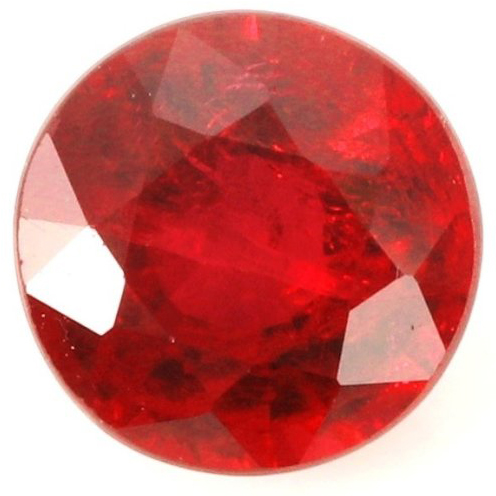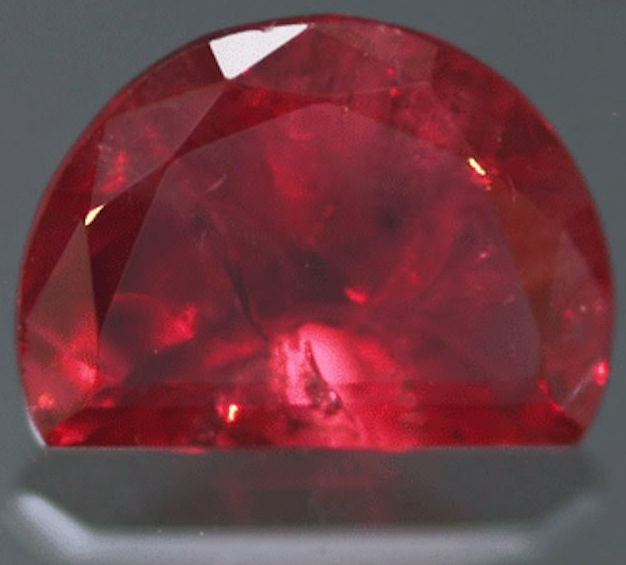Ruby vs. Red Beryl

Red beryl and rubies are completely different gemstones. Red beryl is a variety of the beryl mineral species (like emeralds), while rubies are a variety of the corundum mineral species (like sapphires). Red beryl is also known as Bixbite, which is not to be confused with Bixbyite; another mineral named after Maynard Bixby. To avoid confusion between the two, the term red beryl is used for this type of beryl.
Aside from color, red beryl and rubies have almost nothing in common. They do not even form under similar conditions; their chemical formulas, inclusions, crystal structures, and more all being very different.
Corundum is chemically written as Al2 O3, aluminum oxide. Beryl is written as Be3 Al2 Si6 O18. Despite appearances, these are very different substances.
Ruby

Weight: 0.73 Carats
Origin: Mozambique
Red Beryl

Despite the unusual fancy-cut and incredibly small size, this red beryl is equally included as the ruby on the left. This is amongst the higher-quality examples of red beryl too.
4Cs
In terms of gemstones, let’s consult the 4Cs for fundamental differences.
- Color – The color range is the same in both gems. It is the only factor they have in common.
- Cut – The gem cutter needs to cut rubies and red beryl differently since different types of crystals have different requirements. Rubies are very hard and have no directions it likes to break in, formally called cleavage. Red beryl lacks distinct cleavage but is much more brittle from inclusions, and not as hard.
- Carat Weight – While rubies typically grow small, they can be found to be few carats in size. Red beryl rarely reaches a full carat, usually only being a quarter to a fifth of a carat.
- Clarity – Gemstones are grouped into three categories based on how included they usually are. Aquamarines often form eye-clean , and are considered Type I. Rubies are a form of corundum, which is classified as a moderately included Type II gem. Red beryl is near-always very included like their emerald mineral cousins as Type III gemstones.
Type I
Aquamarine

Type II
Ruby

Type III
Red Beryl

Mining Locations
Since these stones do not share the same formation conditions, mining pockets are scattered all over the world. Rubies have a number of mining sources focused mainly around the Indian Ocean (circled in red on the world map). Red Beryl is only found in the USA, from specific mining claims in Utah and New Mexico; though Utah has been noted for producing a larger amount of gem-quality material. Wah Wah mountains, specifically Crystal Peak, is one location known for spectacular red beryl.


Crystal Systems
Rubies and red beryl grow in different crystal systems, with rubies in the trigonal system and red beryl in the hexagonal system. Out of the many differences between the two, the highlight is they grow in different shapes because of these systems.
Rubies form in shallow crystal rough usually no thicker than a tums tablet, while the red beryl rough will never grow larger than what can be held in one hand.
Another problem for red beryl is the high amount of inclusions that limits the possible gem yield, despite having a more ideal growth habit than rubies. Whether it is sapphires and rubies or emeralds and red beryl, the color red seems to cause a lot of problems with crystal growth. The elements that color rubies and red beryl, chromium and manganese respectively, are rare elements in nature too.


Use In Jewelry
While an appealing color, red beryl is too rare to be widely used in jewelry. Rubies are much more commercially viable as the number of mining sources indicates. It is also possible to find them over a few carats; though be prepared for some staggering prices comparable to a substantial down-payment on your house.
Jewelry ID: J5355
Ruby Carat Weight: 3.31ct
Origin: Mozambique
Treatments: Heated
Total Price: $57,600.00


